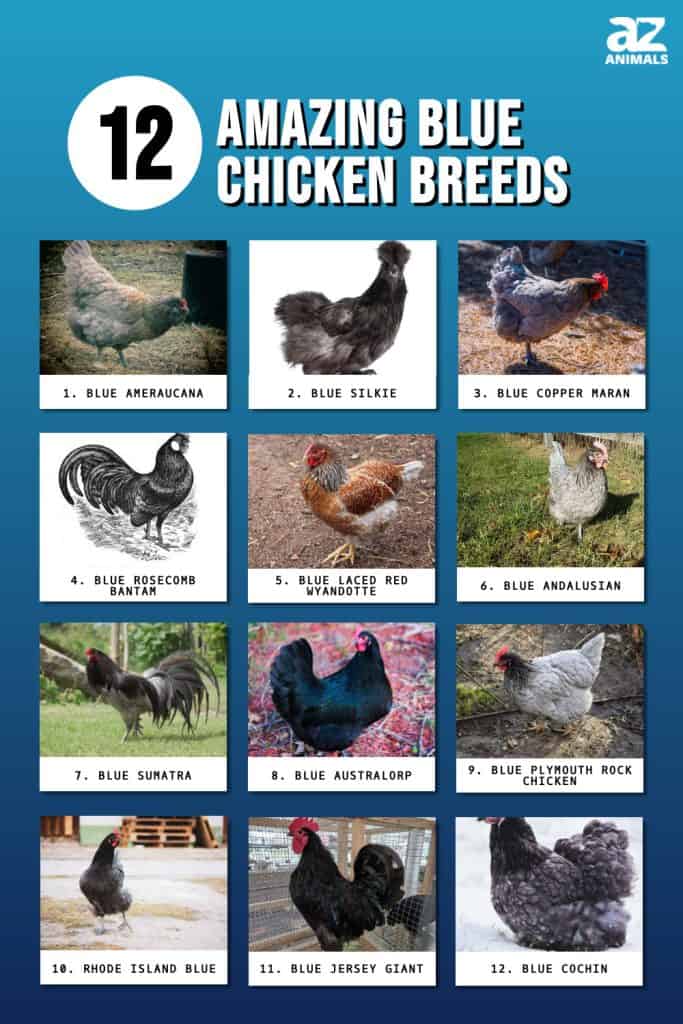
If you’re eager to learn about chickens but want to explore something a little out of the ordinary, we have just the thing for you. In the poultry world, the “blue” gene is quite a remarkable phenomenon.
This gene doesn’t necessarily lead to a bird with entirely blue feathers. Instead, it can spawn a spectrum of colors, including black and splash — a delightful mix of white paired with black or blue feathers, all based on the genetic contribution of both parent birds. Sounds interesting, right? Well, let’s dive into the list of 10 amazing blue chicken breeds that carry this unique genetic trait, showcasing a fascinating variety of feather displays.
1. Blue Ameraucana

Blue Ameraucanas are not only blue — they also lay blue eggs!
©Fyn Kynd / CC-BY 2.0 – License
Many people assume that a blue chicken would naturally produce blue eggs, but this isn’t always true. Nevertheless, such birds do exist. If you want a blue chicken that lays blue eggs, let us introduce you to the blue Ameraucana.
However, don’t expect to find a blue Ameraucana chicken cloaked entirely in a blue color. In most cases, you’re more likely to come across an individual exhibiting a grayish-blue or even a blue-black plumage. This occurs due to the presence of a recessive gene responsible for the blue tint. This merely lessens the intensity of any black pigmentation in the feathers. If the particular chicken doesn’t inherit a copy of the blue gene, its black feathers will retain their original color.
These hens are relatively lightweight, tipping the scales at about 5.5 pounds. On the other hand, the roosters are slightly heavier at around 6.5 pounds, classifying them as “light fowl.”
Their dietary needs are comparable to other chicken varieties. They flourish when given a nutritious mix of premium feed supplemented with fresh fruits and vegetables and occasional treats like mealworms or scratch grains.
The blue Ameraucanas are genuinely delightful, boasting additional feathery tufts on their faces that give them a cute appearance. Plus, they have an endearing personality to boot, getting along well with humans and other chickens alike. But with that said, they appreciate having their own space as well. Despite their easygoing personality, they are not particularly noisy. This is definitely a bonus if you aim to maintain peaceful mornings or prevent complaints from your neighbors!
2. Blue Silkie
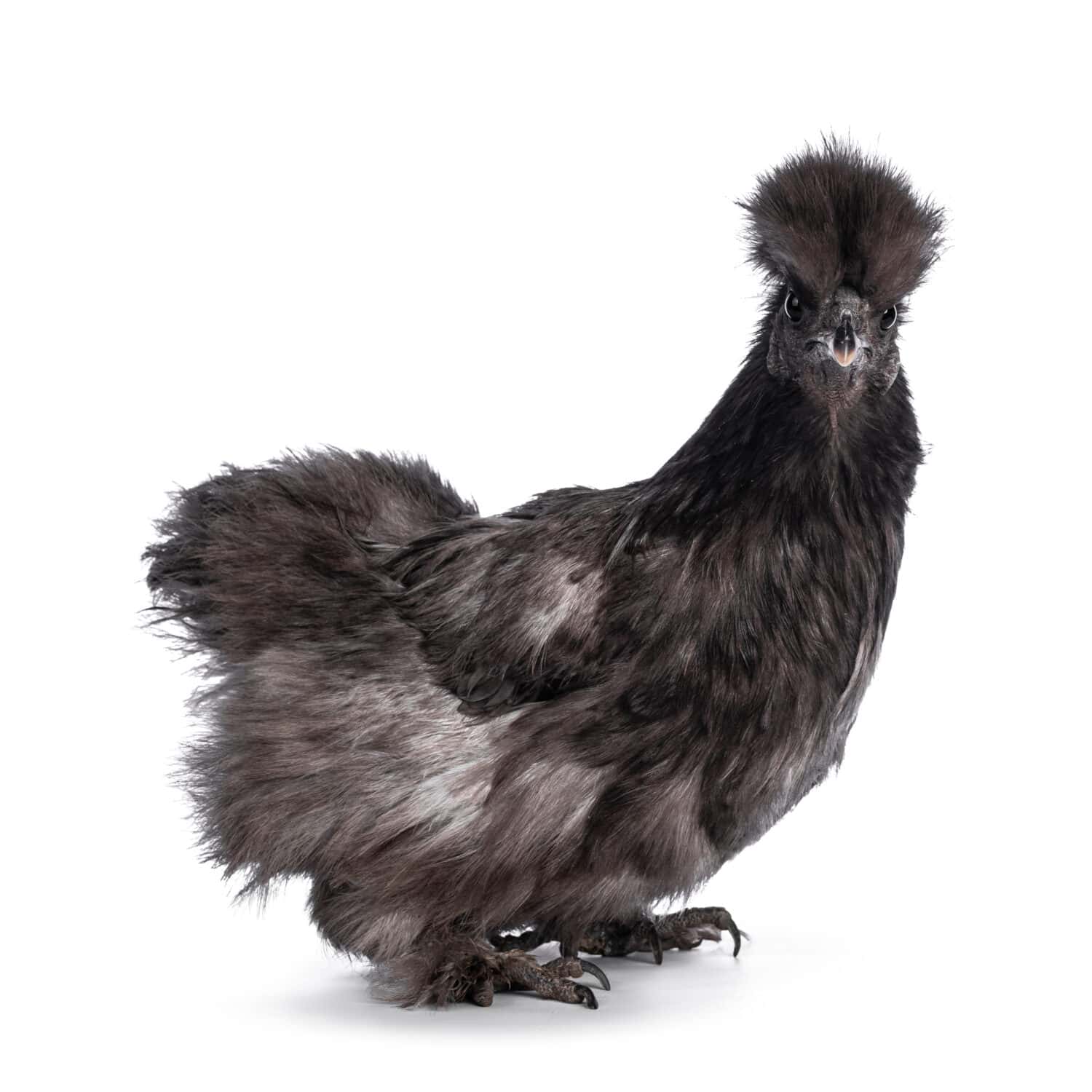
One of the cutest blue chicken breeds in the world is the blue silkie!
©Nynke van Holten/Shutterstock.com
Just like the silkie, blue silkie chickens hold a special place in the hearts of chicken enthusiasts worldwide, largely due to their cuddly and lovely appearance. They stand out among various chicken breeds, boasting a full covering of feathers from their heads down to their feet. Their feathers are not only soft but also resemble fur and have a texture similar to satin or silk. Researchers believe that the silkie chicken has historical roots in China, dating back nearly a millennium. In particular, people lean towards blue silkies because of their distinctive blue and lavender shades.
These chickens are relatively small in size, with males averaging a weight of 4 pounds and females around 3 pounds. Their diet is diverse, as they are omnivores, feeding on a mixture of insects, seeds, fruits, and vegetables.
Blue silkies, or silkies in general, are a perfect choice to consider adding to your household if you fancy having a pet that enjoys a good hug. Their gentle nature means they’re more than happy to indulge in a snuggle now and then.
Though they might be small in size, they are popular for their quality meat. Hidden beneath the lush feathers is a surprising attribute: black skin, meat, and even bones. These are a delicacy and a vital component in certain medicinal recipes in various countries.
3. Blue Copper Maran
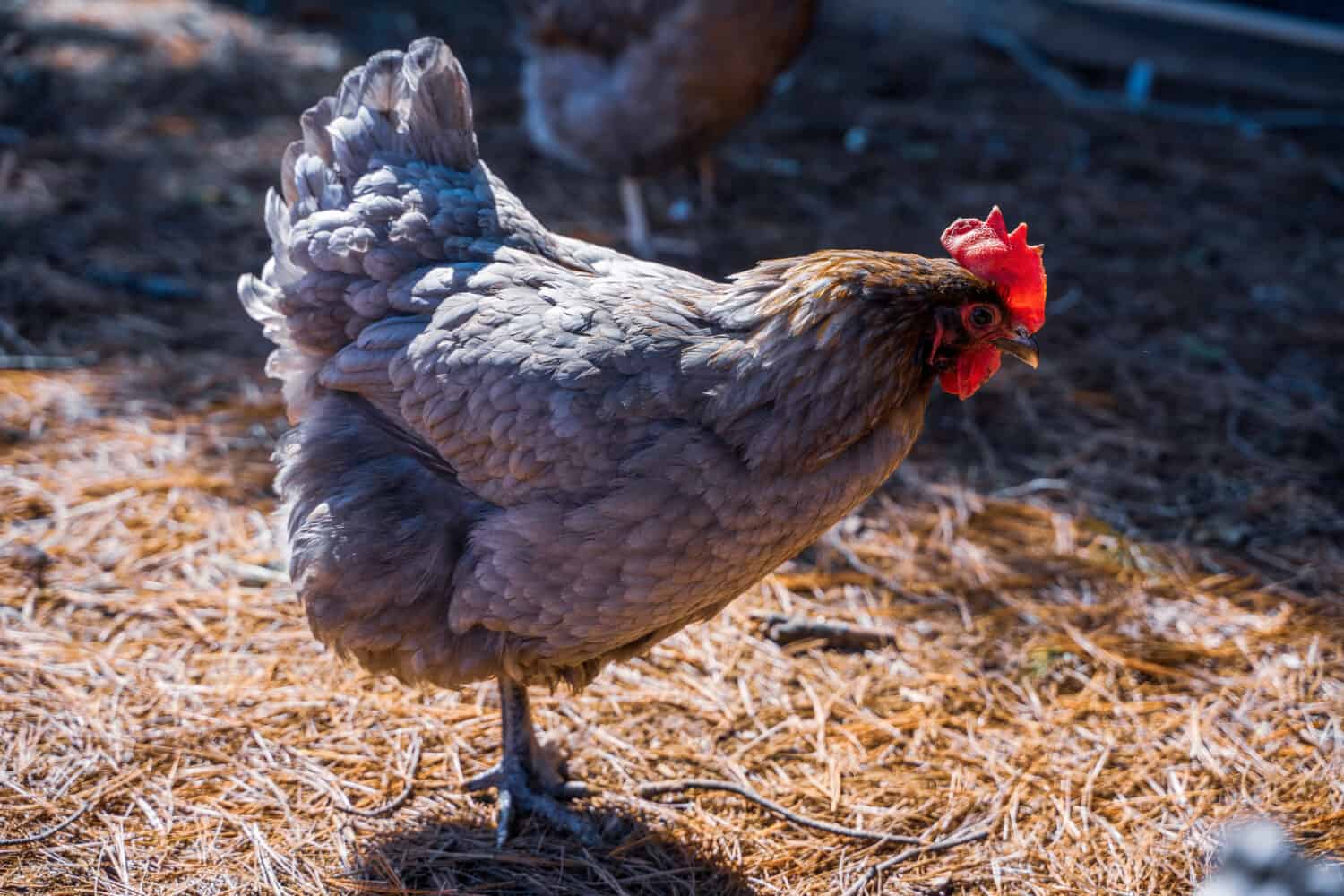
Boasting a copper head, the blue copper Maran chicken is a blue color on the rest of its body.
©Bullet Point Ranch/Shutterstock.com
The blue copper Maran chickens trace their roots to France, perhaps explaining why people often call them French blue copper Maran. These medium-sized birds boast a compact feathering that feels somewhat silky to the touch.
The hens of this breed typically feature a dark to copper color on their head and neck feathers, contrasting sharply with the blue that dominates the rest of their bodies. Notably, their tails are narrow, stretching backward without flaring upwards, a trait quite distinct from certain other chicken breeds.
These chickens are proficient scavengers, with their diet extending beyond insects, larvae, and worms to include larger prey like reptiles.
Generally characterized as docile and easygoing, the temperament of the blue copper Maran can nonetheless vary, with a few individuals displaying more aggressive tendencies. These chickens also tend to be more athletic as well.
Rest assured, these chickens pose no threat to humans, including small children, making them a wise choice for a family pet. These active and elegant birds are noted for their robust health. They exhibit resistance to many diseases that commonly affect other chicken varieties. Notably, copper Marans lay incredibly dark brown eggs, which can add a beautiful contrast to other egg varieties if you keep several varieties of chickens.
4. Blue Rosecomb Bantam
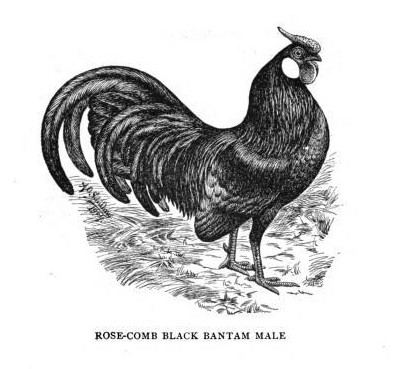
The blue rose comb bantam originated in England during the 1300s.
©The American Standard of Perfection / Public Domain – License
The blue rosecomb bantam is known for a number of unique traits, including its blue-grey feathers, pristine white earlobes, and the distinct comb shape that lends the breed its name. The vivid red comb is rather flat, wide, and closely attached to the head, culminating in a prominent point at its rear. Additionally, the males boast notably long tail feathers that arch gracefully.
This breed originated in England during the 1300s. The blue variant gained official recognition in the American Poultry Association Standard of Perfection in 1960.
These small chickens weights do not exceed 2 pounds. They thrive on a diet consisting of pellets, grain crumbles, and whole grains.
Although they can be gentle and friendly in nature, they may not be the best choice for novice breeders due to their inherent fighting tendencies. The blue rosecomb bantam enjoys popularity mainly as a decorative breed, often stealing the spotlight in showrooms due to its captivating appearance. Typically, they are raised primarily for display and exhibition, especially since these chickens are not particularly known for their egg-laying abilities.
5. Blue Laced Red Wyandotte

The blue laced red Wyandotte is a colorful chicken with a grayish or blueish tinge.
©Alisha Falcone/Shutterstock.com
The Wyandotte chicken has consistently maintained its fame among poultry enthusiasts. In recent times, the blue laced red Wyandotte has become the center of attraction due to its distinctive color patterns. Though they haven’t been officially acknowledged by the American Poultry Association yet, it seems likely that they will be soon.
Wyandottes are generally plump and rounded birds, featuring a full chest and a subtle curve in their back. Their head sports a rose comb, which is complemented by red wattles and earlobes.
They have deep, red-bay eyes positioned just above a horn-tinted beak. Their skin is yellow-toned, supporting their sturdy body on short, robust legs. The blue laced red Wyandotte variety exhibits grayish-blue dense under feathers extending from its abdomen to its tail. Atop this, their back, chest, and flanks showcase reddish-chestnut plumes bordered with gray or blue tinges.
Wyandottes are on the larger side, with hens tipping the scales at about 6.5 pounds, while the roosters can weigh approximately 8.5 pounds. Their diet is naturally supplemented by various seeds and insects they discover during outdoor adventures.
When mingling with other chickens, they tend to maintain a certain distance. They usually prefer the companionship of their own breed rather than mingling with others. While they are not aggressive, they stand their ground firmly when confronted by another bird. Their assertive demeanor discourages others from attempting to bully them.
6. Blue Andalusian
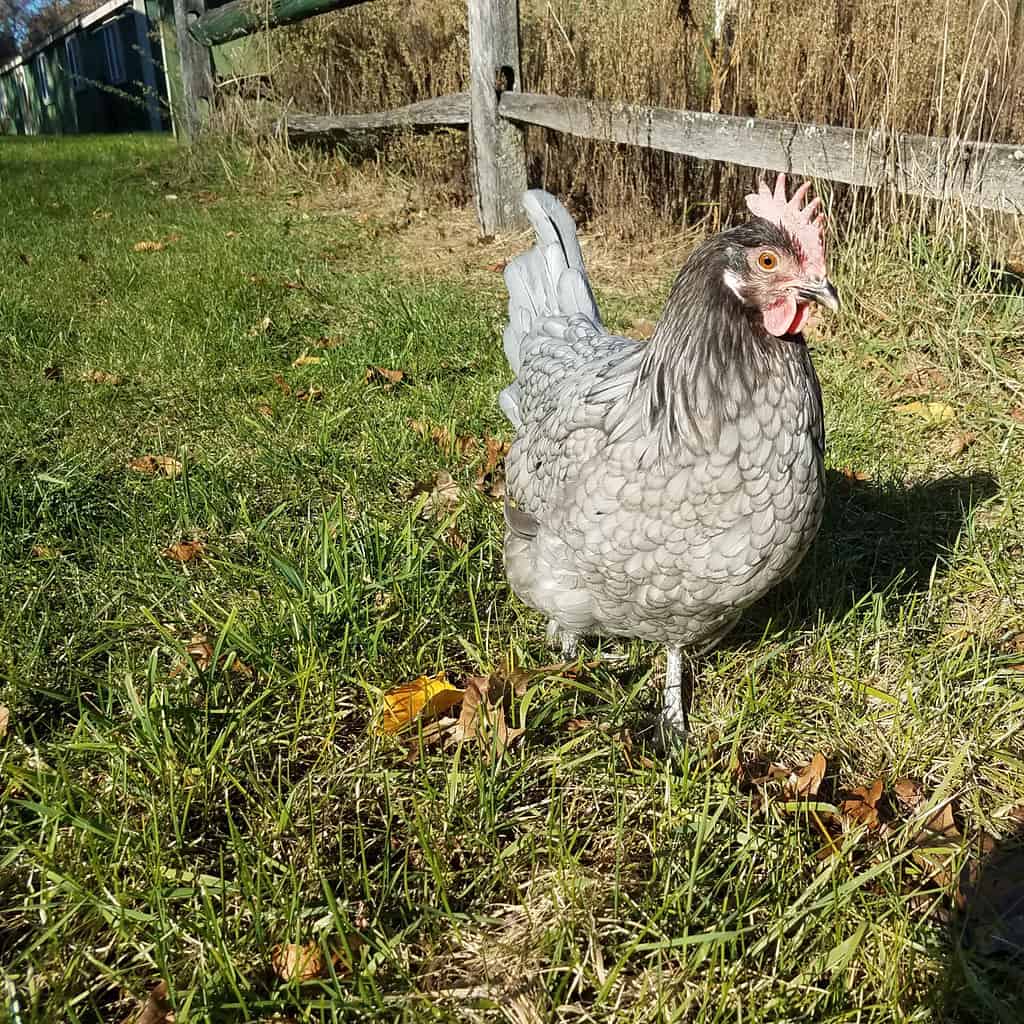
Featuring a blue, laced pattern, blue Andalusians are a popular chicken breed.
©cainphotos/Shutterstock.com
Blue Andalusians, originating from a region in Spain sharing their name, were brought to the United States around the 1850s, where breeders continued to perfect the coloring of the chicken.
These chickens exhibit a stunning bluish-gray hue, a characteristic that extends to their downy under-feathers. Instead of a uniform color, their plumage showcases a blue, laced pattern, highlighted by a darker blue border around each feather. Blue Andalusians can come in a splash color as well. This variety is almost entirely white with some splashes of blue.
Blue Andalusians also feature medium-sized combs with a distinct five-point structure. Additionally, blue Andalusians possess white, moderately sized earlobes accompanied by substantial wattles. Males can weigh approximately 7 pounds, while females weigh about 5 pounds.
Their typical diet encompasses various options like chicken pellets, a mixture of grains, chicken mash, or a combined grain assortment.
Despite the common belief that blue Andalusians are well-suited to cold environments, the reality paints a different picture. Their combs and wattles are quite prone to frostbite, a condition as agonizing for them as it would be for humans. Though they can endure colder climates, it comes at the cost of significant discomfort.
Remarkably alert and quick to respond, blue Andalusians exhibit a keen sense of awareness, always ready to evade potential threats. Their ability to fly, a skill not prevalent in many other chicken breeds, further aids in their defense against predators. Their vocal nature serves as an efficient alarm system, as they don’t hesitate to warn their group at the slightest indication of danger.
7. Blue Sumatra

This breed of chicken known as the blue Sumatra is found in the western part of Indonesia.
©Wanny / CC BY-SA 3.0 DEED – License
As its name suggests, the blue Sumatra finds its roots on Sumatra island, situated in the western part of Indonesia.
Admired as exhibition or ornamental birds, they capture attention with their extravagant tails and distinctively colored faces. As they mature, both males and females develop a shimmering blue coat of feathers, complemented by grayish legs. Their tails, inclusive of their sickles and coverts, can gracefully touch the ground when well-maintained. Females roughly weigh 4 pounds, and males weigh approximately 5 pounds.
These birds have a habit of scavenging, often seen enjoying fresh bugs and pests directly from gardens. Notably, they are among the handful of chicken breeds that can fly, managing to cover a considerable distance when they take to the air.
Although the blue Sumatras dazzle with their bluish feathers, making splendid ornamental additions, their egg-laying capacity is somewhat limited, offering about one or two eggs weekly. Plus, these chickens will tend to get broody, so that’s definitely something to look out for. Moreover, they aren’t typically chosen for their meat.
8. Blue Australorp
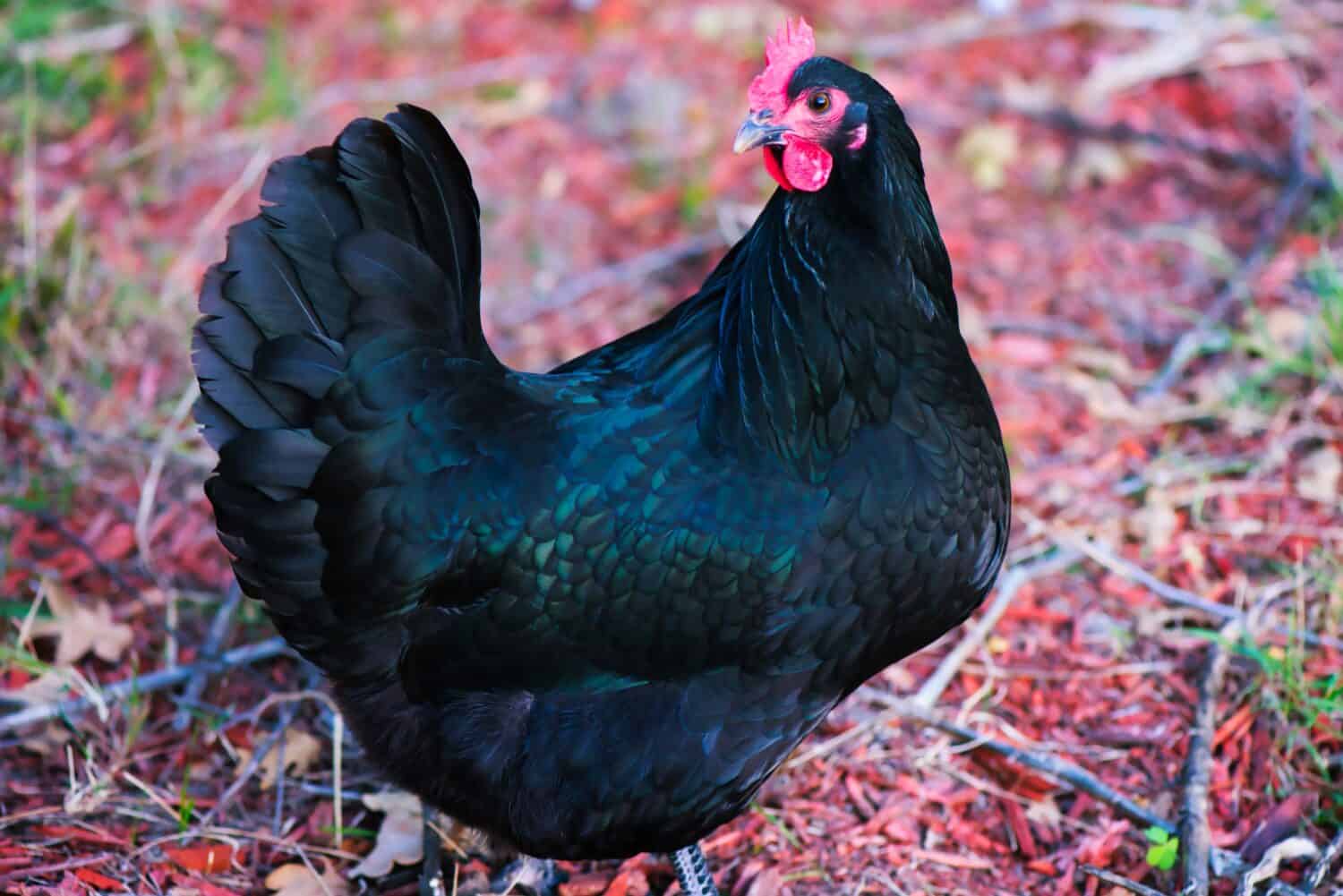
One of the best egg-producing chicken breeds is the blue Australorp.
©Ashley Thomas Photography/Shutterstock.com
The blue Australorp is a relatively rare version of the Australorp chicken, originating from Australia. Their feathers have a unique ability to reflect sunlight, resulting in a magnificent display of bluish-gray, almost iridescent hues that captivate onlookers. These chickens maintain a grand posture, holding their tails upright and showcasing a broad and rounded chest, a testament to their robust and well-formed physique.
In terms of size, adult roosters of this breed generally tip the scales at about 8 to 9 pounds, while the females usually weigh between 6.5 and 7.5 pounds.
Their diet is quite diverse, comprising greens such as weeds and seeds, in addition to a variety of insects, worms, and other small creatures like mice and lizards they might find in their environment.
Given their sizable build, these chickens thrive when they have the opportunity to stay active, helping to prevent obesity, which is a common concern in larger chicken breeds, especially if confined to smaller spaces.
Recognized as one of the premier choices for egg production, the blue Australorp also performs well in shows and farm events.
9. Blue Plymouth Rock Chicken
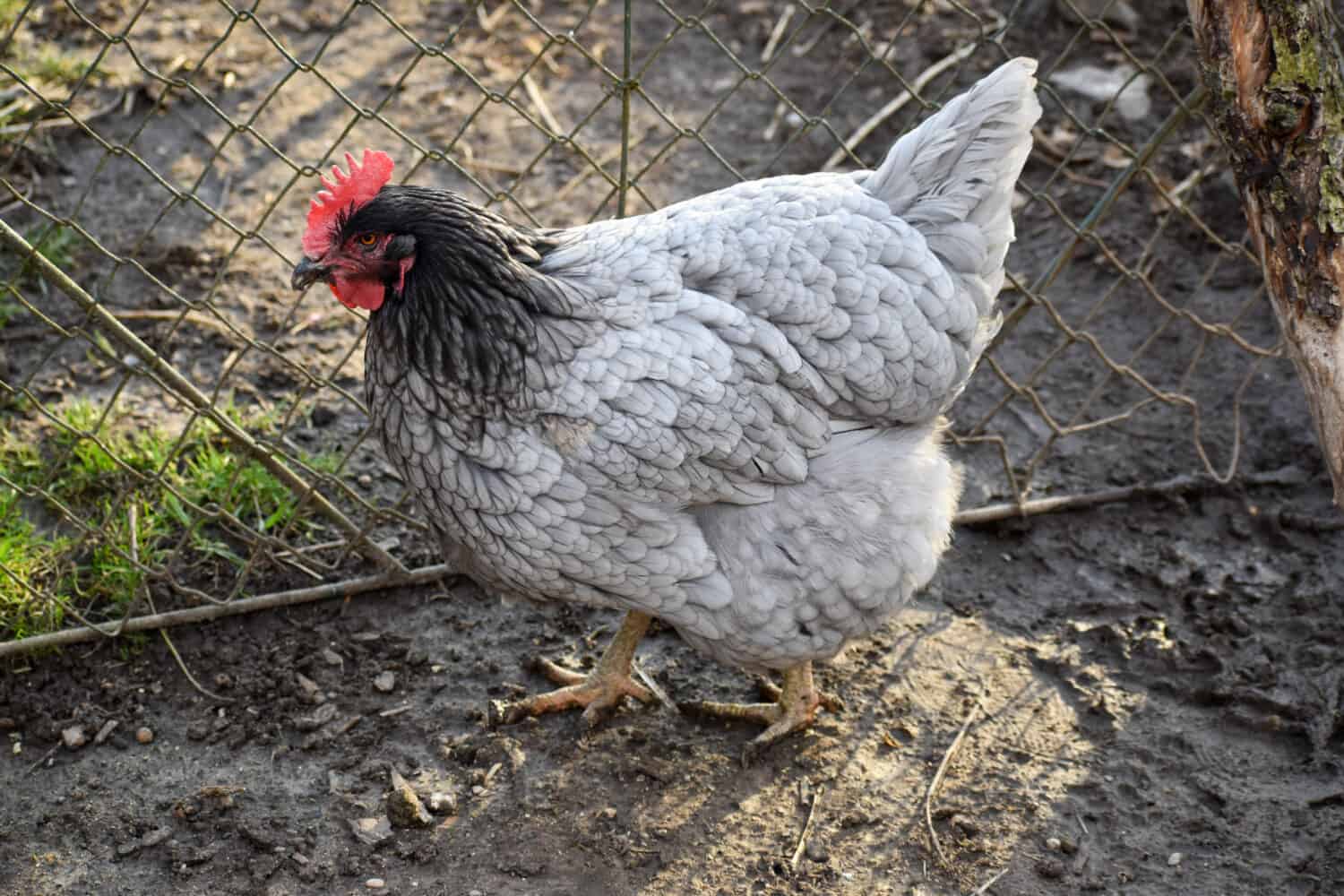
Mostly a blue-gray color, the blue Plymouth Rock chicken has a friendly temperament.
©Monika Valachovic/Shutterstock.com
The blue Plymouth Rock is a fascinating color variant of the original Plymouth Rock chicken, native to the USA.
This breed showcases feathers with a blue-gray color mingled with a soft lavender touch, providing them with a distinguished look. The darker tones on their head and around their neck stand out distinctly against the softer hues on the rest of their bodies. Notably, a gray border can be seen embellishing the blue feathers in the neck area of these chickens.
The hens of this breed are a bit smaller compared to the roosters, but they are still pretty substantial, weighing in at around 6 pounds. The roosters, on the other hand, generally tip the scales around 7 pounds.
Their diet is diverse, including a mixture of feed, grains, and an array of fruits and vegetables, complemented by a selection of insects for protein.
In terms of temperament, these chickens are among the most approachable and friendly you’ll find. They have a curious nature, frequently seen exploring their surroundings energetically. Additionally, they are well-adapted to various climates and can withstand cold winters without a dip in egg production.
10. Rhode Island Blue
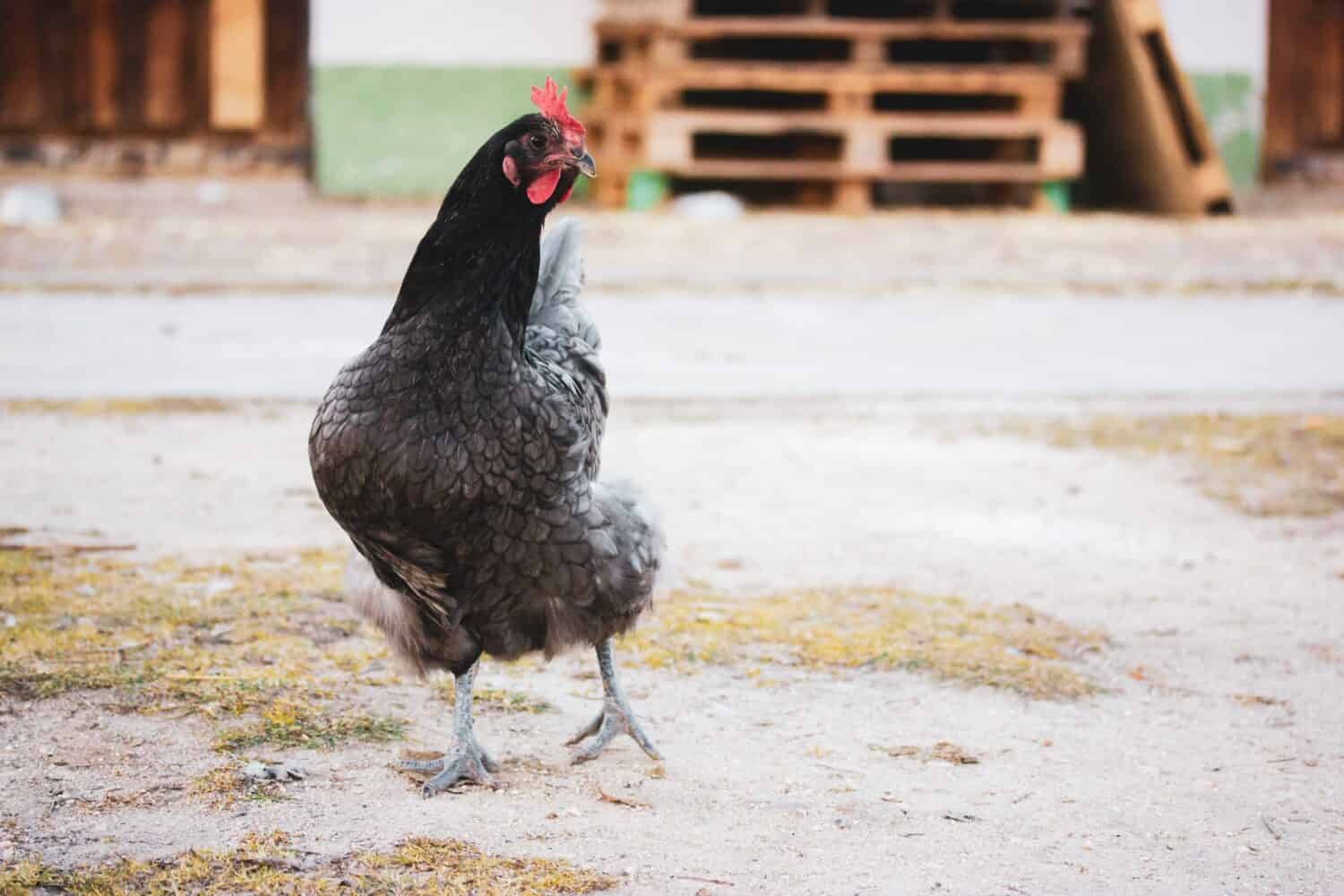
A cross of the Rhode Island red chicken and the blue Australorp chicken, the Rhode Island blue chicken boasts some blue in its plumage.
©Al More/Shutterstock.com
The Rhode Island blue chicken was developed in the United States. This amazing chicken breed beautifully blends the resilience and high yield of the renowned Rhode Island red chicken with a striking blue color, a trait borrowed from the blue Australorp breed.
These chickens sport a spectrum of blue in their plumage, varying from light to dark shades, sometimes presenting a sprinkle of other colors due to their diverse lineage. They boast a broad and sturdy frame, indicative of their meat-producing potential, characterized by a somewhat rectangular shape with slightly deep chests.
Adult male chickens of this breed can reach weights between 8 and 9 pounds, while the females generally settle at a slightly lighter range of 6 to 7 pounds.
Their diet is rich and varied, encompassing a range of fruits, vegetables, grains, and occasionally some leftover table scraps.
These chickens have prolific brown egg-laying capabilities, laying beautiful brown eggs. Not only are they efficient layers, but they also excel at foraging, a trait that assists in pest control and can potentially reduce feed costs, provided they have sufficient space to roam freely.
Furthermore, their friendly nature makes them a great fit for families and enthusiasts who raise chickens as a hobby.
11. Blue Jersey Giant
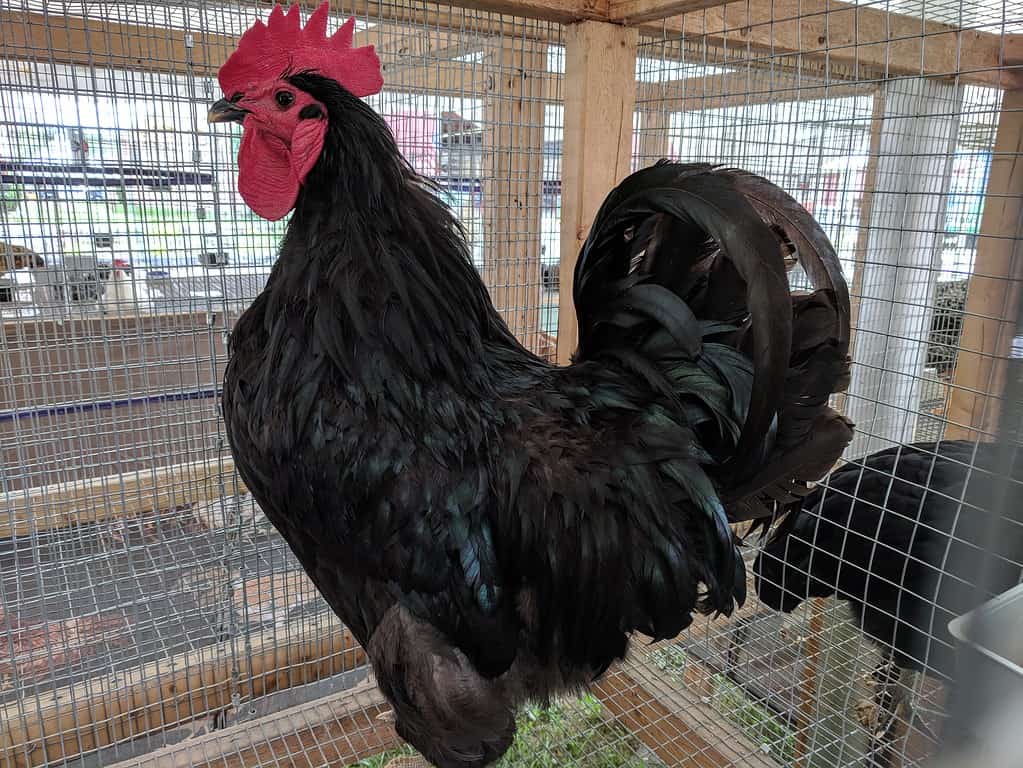
Adult female blue Jersey giants weigh 10 pounds, while adult males weigh around 13 pounds!
©DanielPenfield / CC BY-SA 4.0 – License
As evidenced by its name, the Jersey giant is an American domestic chicken breed created in New Jersey. These birds have your classic chicken look with a single, medium-sized comb, red wattles, and earlobes. Their eyes are typically brown in color, and they have strong and sturdy legs. Adult female blue Jersey giants generally weigh an incredible 10 pounds, while adult males weigh around 13 pounds! In terms of the blue variety, the blue Jersey giant boasts a magnificent blue coloring. The deep blue feathers cover the entire body, and they have a glossy sheen that adds to their beauty.
The blue Jersey giant’s diet is the same as most other chickens, typically comprising high-quality poultry feed along with grains and fresh greens. In terms of personality, blue Jersey giants are renowned for their gentle and docile temperament, making them a favorite choice among families and hobbyists. They are sociable birds that tend to get along well with other chickens and humans. As one of the largest chicken breeds in the world, blue Jersey giants are a great choice for consumption as well. Plus, they lay quite large eggs!
12. Blue Cochin
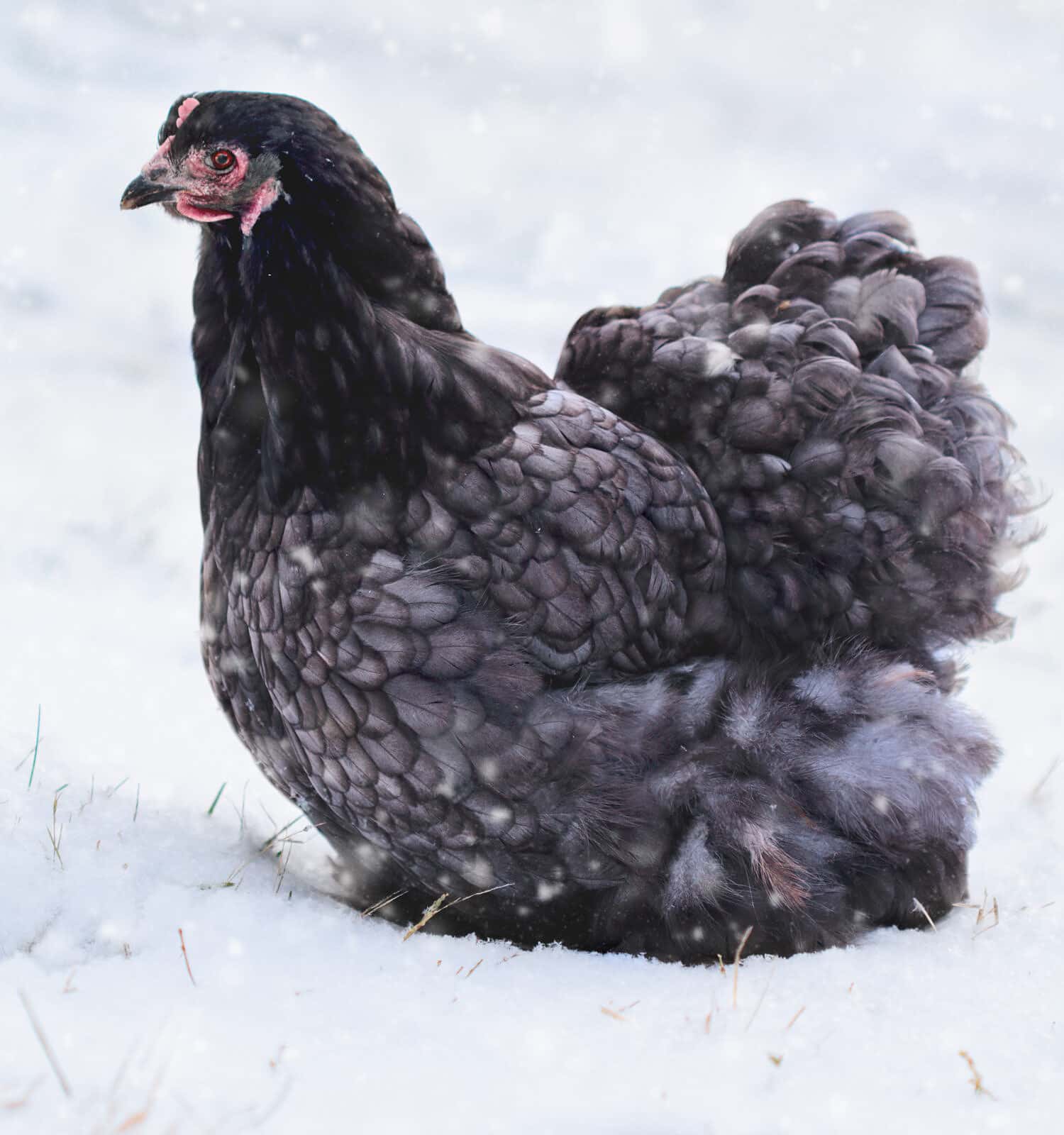
The blue cochin is an incredibly fluffy chicken breed.
©Stephanie Frey/Shutterstock.com
Originally from China, the cochin has a fluffy plumage and docile nature. One of the most striking features of the blue cochin is its voluminous blue feathers. The blue coloration itself is soft and appealing, creating a lovely visual contrast against their bright red wattles and earlobes. Notably, these chickens also have feathered legs, which add to their overall fluffiness.
In terms of size, blue cochins are medium to large birds. Adult females typically weigh around 8 pounds, while roosters can reach weights of 10 to 11 pounds. These chickens thrive on a diet of high-quality poultry feed supplemented with grains, fruits, and vegetables. Make sure to feed them extra protein during the molt!
Blue cochins have a sweet and laid-back temperament and are friendly and sociable. While blue cochins may not be the most prolific egg layers in the chicken world, they do produce a respectable number of large brown eggs — around 150 to 180 a year.
Summary of 12 Amazing Blue Chicken Breeds
| Number | Chicken | Lifespan |
|---|---|---|
| 1. | Blue Ameraucana | 7-8 years |
| 2. | Blue Silkie | 7-9 years |
| 3. | Blue Copper Maran | 5-8 years |
| 4. | Blue Rosecomb Bantam | 4-8 years |
| 5. | Blue Laced Red Wyandotte | 6-12 years |
| 6. | Blue Andalusian | 5-8 years |
| 7. | Blue Sumatra | 6-8 years |
| 8. | Blue Australorp | 6-10 years |
| 9. | Blue Plymouth Rock Chicken | 8-10 years |
| 10. | Rhode Island Blue | 8 years |
| 11. | Blue Jersey Giant | 8-10 years |
| 12. | Blue Cochin | 8 years |
The photo featured at the top of this post is © Ashley Thomas Photography/Shutterstock.com
Thank you for reading! Have some feedback for us? Contact the AZ Animals editorial team.






